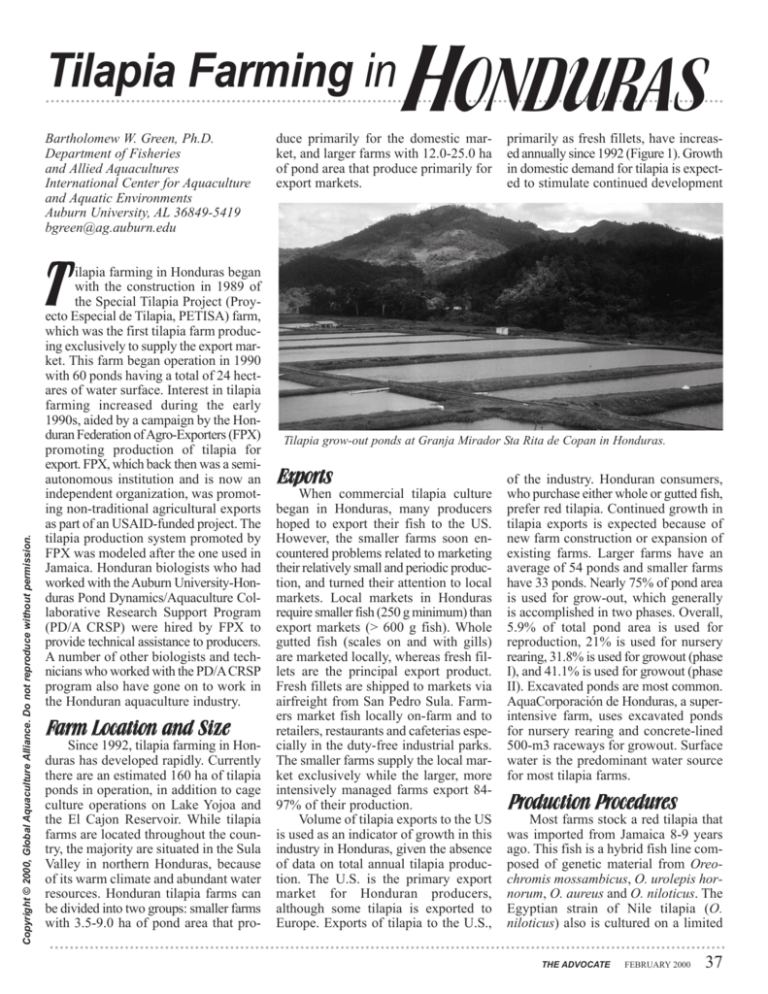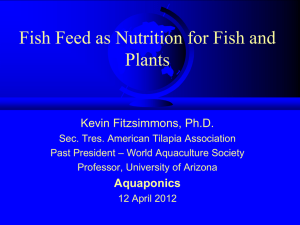Tilapia Farming in Honduras - Global Aquaculture Alliance
advertisement

Tilapia Farming in Bartholomew W. Green, Ph.D. Department of Fisheries and Allied Aquacultures International Center for Aquaculture and Aquatic Environments Auburn University, AL 36849-5419 bgreen@ag.auburn.edu HONDURAS duce primarily for the domestic market, and larger farms with 12.0-25.0 ha of pond area that produce primarily for export markets. primarily as fresh fillets, have increased annually since 1992 (Figure 1). Growth in domestic demand for tilapia is expected to stimulate continued development Copyright © 2000, Global Aquaculture Alliance. Do not reproduce without permission. T ilapia farming in Honduras began with the construction in 1989 of the Special Tilapia Project (Proyecto Especial de Tilapia, PETISA) farm, which was the first tilapia farm producing exclusively to supply the export market. This farm began operation in 1990 with 60 ponds having a total of 24 hectares of water surface. Interest in tilapia farming increased during the early 1990s, aided by a campaign by the Honduran Federation of Agro-Exporters (FPX) promoting production of tilapia for export. FPX, which back then was a semiautonomous institution and is now an independent organization, was promoting non-traditional agricultural exports as part of an USAID-funded project. The tilapia production system promoted by FPX was modeled after the one used in Jamaica. Honduran biologists who had worked with the Auburn University-Honduras Pond Dynamics/Aquaculture Collaborative Research Support Program (PD/A CRSP) were hired by FPX to provide technical assistance to producers. A number of other biologists and technicians who worked with the PD/A CRSP program also have gone on to work in the Honduran aquaculture industry. Farm Location and Size Since 1992, tilapia farming in Honduras has developed rapidly. Currently there are an estimated 160 ha of tilapia ponds in operation, in addition to cage culture operations on Lake Yojoa and the El Cajon Reservoir. While tilapia farms are located throughout the country, the majority are situated in the Sula Valley in northern Honduras, because of its warm climate and abundant water resources. Honduran tilapia farms can be divided into two groups: smaller farms with 3.5-9.0 ha of pond area that pro- Tilapia grow-out ponds at Granja Mirador Sta Rita de Copan in Honduras. Exports When commercial tilapia culture began in Honduras, many producers hoped to export their fish to the US. However, the smaller farms soon encountered problems related to marketing their relatively small and periodic production, and turned their attention to local markets. Local markets in Honduras require smaller fish (250 g minimum) than export markets (> 600 g fish). Whole gutted fish (scales on and with gills) are marketed locally, whereas fresh fillets are the principal export product. Fresh fillets are shipped to markets via airfreight from San Pedro Sula. Farmers market fish locally on-farm and to retailers, restaurants and cafeterias especially in the duty-free industrial parks. The smaller farms supply the local market exclusively while the larger, more intensively managed farms export 8497% of their production. Volume of tilapia exports to the US is used as an indicator of growth in this industry in Honduras, given the absence of data on total annual tilapia production. The U.S. is the primary export market for Honduran producers, although some tilapia is exported to Europe. Exports of tilapia to the U.S., of the industry. Honduran consumers, who purchase either whole or gutted fish, prefer red tilapia. Continued growth in tilapia exports is expected because of new farm construction or expansion of existing farms. Larger farms have an average of 54 ponds and smaller farms have 33 ponds. Nearly 75% of pond area is used for grow-out, which generally is accomplished in two phases. Overall, 5.9% of total pond area is used for reproduction, 21% is used for nursery rearing, 31.8% is used for growout (phase I), and 41.1% is used for growout (phase II). Excavated ponds are most common. AquaCorporación de Honduras, a superintensive farm, uses excavated ponds for nursery rearing and concrete-lined 500-m3 raceways for growout. Surface water is the predominant water source for most tilapia farms. Production Procedures Most farms stock a red tilapia that was imported from Jamaica 8-9 years ago. This fish is a hybrid fish line composed of genetic material from Oreochromis mossambicus, O. urolepis hornorum, O. aureus and O. niloticus. The Egyptian strain of Nile tilapia (O. niloticus) also is cultured on a limited THE ADVOCATE c FEBRUARY 2000 37 basis in Honduras. Most fingerlings are produced on-farm, although off-farm purchases are made in response to production shortfalls. Fingerlings generally are produced in earthen ponds that average 1,200 m2 in size. Reproduction ponds are stocked with 11,000 females/ha and 4,000 males/ha; the ratio of female:male brood fish is about 3:1. Female and male brood fish average 323 g and 460 g, respectively. A locally manufactured, extruded, 30%protein diet is fed to brood fish at a mean daily rate of 1.9% of biomass, six days per week. All farms stock male (sex reversed) fingerlings in production ponds. Fry to be sex reversed are harvested by seining the reproduction pond edges with fine-mesh nets. Partial harvests of fry begin 10 to 22 days after brood fish are stocked into ponds, and continue daily usually for 3 to 10 days. This method yields 20-60 fry/kg of female brood fish on a daily basis. Fry production decreases by 50-70% during November to February because water temperature is lower than 22º C. At farms located at higher elevations, tilapia reproduction ceases during December and January because water temperatures drop below 20º C. Reproduction ponds are drained following each fingerling production cycle. Pond bottoms are allowed to dry between cycles, and puddles that remain on pond bottoms are treated with chlorine solution or hydrated lime to eliminate any remaining fry. Fry harvested from reproduction ponds generally undergo sex reversal in concrete tanks of 250 m2 average size. Mean fry stocking rate in tanks is 2,286 fry/m2. Sex reversal is accomplished by feeding fry a finely ground feed with oral 17 alpha-methyltestosterone (MT) aged by exchanging from 5-20% of pond volume daily. Standing crop at harvest tends to be higher in ponds that receive water exchange (6,800 kg/ha) compared to ponds without water exchange (3,538 kg/ha). Aerators rarely are used in ponds during the nursery phase. Tilapia cage module in El Cajon hydroelectric reservoir, Honduras. Total Weight (kg) Most farms grow fish to market size during two grow out phases in 0.3-ha earthen ponds. During the 83-day growout phase I, fish are stocked into ponds at an average of seven fingerlings/m2 for growth from 39 to 150 grams. At harvest of growout I ponds, mean fish biomass is 5,040 kg/ha, and 85% of stocked fish are harvested. Fish stocking rate decreases to an average of 3.9 fish/m2 during the107-day growout phase II. Female fish are sorted and removed from fish populations as fish are transferred from growout phase I to growout phase II. Fish average weight increases from 155 to 414 grams during growout II. Average fish biomass at harvest of growout II ponds is 14,397 Fresh Fillet Frozen Fillet Whole Frozen kg/ha. Fish survival averages 90%. Fish are fed a 30% protein floating, extruded feed six days per week during both 800,000 phases. Feed conversion ratios for each 700,000 phase vary from 2.0-3.5:1. 600,000 Two farms practice more intensive culture techniques than those used for 500,000 pond culture: raceway culture and cage 400,000 culture operations in Lake Yojoa and the 300,000 El Cajon hydroelectric reservoir. The 200,000 raceway farm draws its water from the outflow of the Rio Lindo hydroelectric 100,000 plant, which draws water from Lake 0 Yojoa. Discharge from the hydroelec1992 1993 1994 1995 1996 1997 1998 19 tric plant varies diurnally from 13-23 m3/s; the supply canal to the raceway Ye ar farm carries six m3/s from the hydroFigure 1. Tilapia exports from Honduras to the United States as fresh or frozen fillets, and as whole frozen fish (1992-1999). Data from 1999 are for January through electric plant discharge canal. ProducNovember. tion of stocker fingerlings is accom- 38 THE ADVOCATE c FEBRUARY 2000 incorporated at 60 mg per kg feed. Treatment duration is 28-30 days. Fry average 0.4 g after treatment. Survival during MT treatment averages 57%. Efficacy of sex reversal averages 94.4% males. After sex reversal treatment, fingerling are reared in 0.3-ha earthen ponds to an advanced fingerling size. Fingerlings stocked into ponds at an average of 26 fish/m2 grow from 0.5 to 37.1 g in 67 days. Harvest biomass averages 5,169 kg/ha. Fingerling survival averages 71%. Fish are fed a 30% protein extruded feed, six days per week. On many farms, pond water quality is man- is offered frequently from 0800-1600 h. Duration of growout phase I is 60 days, at which time fish average 100 g and standing stock is 12.4 kg/m3. Growout phase I survival is 70%. Fish stocking rate is reduced to 35 fish/m3 for growout phase II. During the 10-month production cycle fish grow from 100 g to 800 g. Fish are fed a 28%-protein extruded feed, which is offered frequently from 0800-1600. Standing stock at harvest is 22.5 kg/m3, and survival averages 80%. Tilapia reproduction ponds at Aquacorporacion de Honduras. plished in earthen ponds at the raceway and cage culture operations, while during the growout phases, operations shift to concrete raceways or cages. On the farm using flowing water culture, growout phases I and II are conducted in 500-m2 concrete raceways. During growout phase I, fingerlings are stocked at 130 fish/m2 and grow from 64 to 360 g in the 121-day grow out period. Fish biomass upon completion of phase I averages 39.8 kg/m3, and 85% of stocked fish survive. Stocking rate for growout phase II is reduced to 48 fish/m2. Fish are grown from 360 g to 925 g in 131 days. Standing stock at harvest is 40.8 kg/m3. Survival during growout II averages 92%. Fish in both growout phases are offered a 32%-protein extruded feed frequently from 0800-1600 h. On average, one complete raceway volume is exchanged per hour during both growout phases. In the cage culture operation, 20-g fingerlings harvested from nursery ponds are transported for stocking into cages for a two-phase growout. Cages (170 m3) are grouped in modules of six cages, and each module is positioned 50 m from adjacent modules. Fish are stocked into cages at 176 fish/m3 and fed a 35%-protein extruded feed, which Conclusion Tilapia farming has become an established aquacultural activity in Honduras since its beginnings a decade ago. The industry evolved from an exportonly orientation to one that supplies both domestic and export markets. Continued development of domestic and export markets will stimulate expansion of existing farms and development of new farms to meet demand. The future looks bright for Honduran tilapia producers. THE ADVOCATE c FEBRUARY 2000 39





